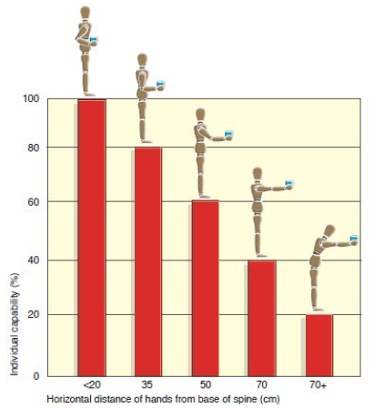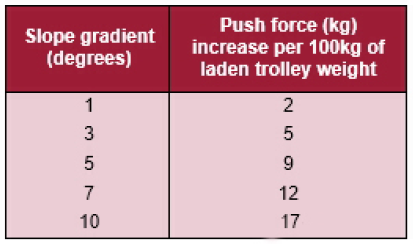Title Page
-
Company
-
Site
-
Task
-
Location
-
Date and Time of Assessment
-
Assessment prepared by
RISK ASSESSMENT LIFTING AND CARRYING
PRELIMINARY
-
Task Name
-
Task Description
-
Load Weight
-
Frequency of Lift
-
Carry Distances (if applicable)
-
Are other manual handling tasks carried out by these operators?
-
Assessment discussed with employees/safety representatives:
-
Operations covered by this assessment (detailed description):
-
Locations
-
Personnel involved
-
Date of Assessment
RISK ASSESSMENT LIFTING AND CARRYING
LIFTING AND CARRYING
-
Levels of Risk:
DO THE TASKS INVOLVE:
-
Holding loads away from torso?
-
Advice
-
- As the load is moved away from the trunk the general level of stress on the lower back rises. Regardless of the handling technique used, not keeping the load close to the body will increase the stress. As a rough guide, holding a load at arm's length imposes about five times the stress experienced when holding the same load very close to the trunk. Figure 1 shows how individual handling capacity reduces as the hands move away from the trunk.
- Also, the further away the load, the less easy it is to control. Friction between the load and the worker's garments can help to support or steady the load. If the load is moved away from the body, this benefit is reduced or lost, and it is more difficult to counterbalance the load with the weight of the trunk. -
Twisting?
-
Advice
-
- Stress on the lower back increases significantly if the torso is twisted during manual handling. This stress is made worse if twisting and bending of the spine occur at the same time. One-handed handling will tend to load the spine unevenly and may encourage twisting, but is appropriate for some loads. When loads are very light then one-handed handling will not significantly increase what is a very low risk.
- Where there is some twisting while handling (for example less than 45° twist between the shoulders and the feet) and the load is relatively light, then a Medium risk level may be appropriate. Where there is high levels of twisting (for example greater than 45° between the shoulders and the feet); where twisting is done at the same time as stooping or stretching, or when twisting with a heavy load, then consider scoring High risk. -
Stooping?
-
Advice
-
- Stooping increases the stress on the lower back because the back muscles have to support the weight of the upper body, as well as the weight of the load, which increases the risk of injury. However, stooping slightly is preferable to adopting a deep squatting posture, which can place excessive loads on the knees and hips.
- The current layout of the task increases the need to stoop when carrying out manual handling tasks.
- Lifting the load lifted from below the level of a workbench / work top increases the level of stooping.
- Are there fixed obstructions, such as shelves, underneath stairways or store cupboards present that restrict headroom or reduce direct access to the load and consequently induce stooping. -
Reaching upwards?
-
Advice
-
- Reaching upwards, especially above shoulder level, to access or place the load reduces control and takes arms away from the body, increasing the risk of injury.
- Transition of the load from floor to a high shelf for example - excessive range of manual movement of load.
- Working surfaces at various heights leading to repetitive transition whilst transferring load. -
Large vertical movement?
-
Advice
-
- Requirement to lift or lower the load through large vertical distances.
-
Long carrying distances?
-
Advice
-
- Is the load being carried over distances in excess of 10 metres.
Note - even relatively light loads if carried over long distances prolongs physical stresses, induces fatigue and can increase the risk of injury. -
Strenuous pushing or pulling?
-
Advice
-
- Excessive pushing and pulling - exposing the neck, back and shoulders to injury.
- Long distances - involving pushing and pulling - even with a mechanical aid such as a sack trolley.
- Repeated journeys, involving heavy loads - leading to fatigue and increasing the risk of injury.
- Sliding boxes, bales of hay, furniture over floor surfaces using pushing or pulling actions.
- Obstacles or narrow, low passage ways - restricting position and posture.
- Uneven / damaged floors.
- Floor surfaces such as carpets leading to an increase in the co-efficient of friction between the load and floor surface.
- Extent of grip between the floor and footwear - in general, higher the grip the lower the risk of injury.
The task is likely to be low risk if:
- the force is applied with the hands; and
- the torso is largely upright and not twisted; and
- the hands are between hip and shoulder level; and
- the distance involved is no more than about 20m. -
Unpredictable movement of loads?
-
Advice
-
- Is the load fixed firmly in place - such as in a tight corner, or shelf - if so beware of extra effort to release the stored energy.
- Potential for unpredictable movements when moving people or animals - children, patients in bed and pets / farm animals.
- Freeing something that is jammed in a machine can easily cause injury. -
Repetitive handling?
-
Advice
-
- Extent of repeated handling - note a relatively light load lifted frequently can lead to significant injuries as fatigue increase and stresses build in muscles and joints.
- To what extent is the posture fixed during these operations - lack of movement can lead to a reduction in blood flow to muscles, increasing fatigue and potential injury. -
Insufficient rest or recovery?
-
Advice
-
- Extend of the opportunity to rest and recover - the greater this is applied the lower the risk of injury and ill health.
- Are breaks mandatory at fixed times or can they be taken voluntarily at intervals determined by the individual. Note - fixed breaks are less effective as they don't take account of individual fitness and work rate of different personnel. -
A work rate imposed by a process?
-
Advice
-
- Considered higher risk when the rate of manual handling is determined by a process, such as picking activities in a warehouse or a production line activity requiring loading or unloading, where typically the opportunity for rest breaks is fixed and less effective than ad-hoc rests based on personal fitness and strength.
ARE THE LOADS:
-
Heavy?
-
Advice
-
The Regulations do not set specific requirements such as weight limits. While weight is an important factor, there are many other risk factors which you need to take into account, such as:
- Size
- Rigidity
- Shape
- Resistance to movement, such as frictional forces when pushing and pulling;
Note: - splitting the load will reduce the weight but also result in more trips, greater frequency of lifting, which in turn increases the risk of fatigue and repetitive strain injuries. A balance between heavy weights and number of lifts should be found. -
Bulky or unwieldy?
-
Advice
-
- If the bulk of the load prevents it from being able to pass between the knees the risk of injury is increased. The handler needs to be able to get close to the load in order to lift it with less strain to their bodies.
- If the bottom front corners of a load are not within reach when carried at waist height it will be harder to get a good grip.
- If handlers have to lean away from a load to keep it off the ground when carrying it at their side, they will be forced into unfavourable postures.
- The risk will be further increased if the load does not provide convenient hand holds. This risk is further accentuated if any dimension of the load exceeds 75 cm.
- To what extent is vision restricted as a consequence of the bulk of the load? Restricted vision increases the risk of tripping, slipping and bumping into objects.
- The risk of injury will also be increased if the load is unwieldy and difficult to control. Well-balanced lifting may be difficult to achieve, the load may hit obstructions, or it may be affected by gusts of wind or other sudden air movements.
- If the centre of gravity of the load is not positioned centrally within the load, inappropriate handling may increase the risk of injury. For example, loads which have much of the weight at the back should not be lifted from the front. This will place its centre of gravity further from the handler's body than if it is approached from the other side or is turned around and lifted from the back.
- Sometimes, as with a sealed and unmarked package, an offset centre of gravity is not immediately apparent. In these circumstances, there is a greater risk of injury since the handler may unwittingly hold the load with its centre of gravity further from the body than is necessary. -
Difficult to grasp?
-
Advice
-
- If the load is difficult to grasp, for example because it is large, rounded, smooth, wet or greasy, its handling will call for extra grip strength, which is tiring and will probably involve inadvertent changes of posture. There will also be a greater risk of dropping the load. Handling will be less easy and the risk of injury will be increased. Using gloves may also make a load more difficult to hold.
- If hand holds are provided as part of the load or within any container they should be wide enough to clear the width of the palm, and deep enough to accommodate the knuckles and any gloves which may need to be worn. -
Unstable or unpredictable?
-
Advice
-
- If the load is unstable, for example if it lacks rigidity or has contents that are liable to shift, the risk of injury is increased. The stresses arising during the manual handling of such a load are less predictable, and the instability may impose sudden additional
stresses for which the handler is not prepared. This is particularly true if the handler is unfamiliar with a particular load and there is no cautionary marking on it. -
Intrinsically harmful (eg sharp/hot)?
-
Advice
-
- There may be a risk of injury from contact with the load. It may have sharp edges or rough surfaces, or be too hot or too cold to touch safely without protective clothing. In addition to the more obvious risk of direct injury, such characteristics may also impair grip, discourage good posture or otherwise interfere with safe handling.
- Handling animals which may react in an unpredictable way can increase the risk of injury.
CONSIDER THE WORKING ENVIRONMENT - ARE THERE:
-
Constraints on posture?
-
Advice
-
If the working environment prevents working at a safe height or adopting a good posture, the risk of injury from manual handling will be increased. For example:
- low work surfaces or restricted headroom will result in a stooping posture;
- furniture, fixtures or other obstructions may increase the need for twisting or leaning;
- constricted working areas and narrow gangways will make it more difficult to manoeuvre bulky loads. -
Poor floors?
-
Advice
-
- Presence of uneven, slippery or unstable floors
- Floor contamination - spillages of water, oil, soap, food, grease etc.
- Floor surfaces subject to movement - for example trains, boats, - reduce stability and are often unpredictable - braking,
accelerating
- Pushing and pulling on floor surfaces - effort and risk increases if surfaces poor, gradients, uneven. It is recognised that uneven surfaces can require an additional 10% of applied force to start the load moving -
Variations in levels?
-
Advice
-
- Presence of steps, steep slopes etc. can increase the risk of injury by making movement more difficult when handling loads.
- Carrying a load up or down a ladder, if it cannot be avoided, is likely to make handling problems worse because of the need to keep a hold on the ladder.
Note: Another risk from pushing/pulling on a slope is that the forces involved are increased. For example, for a load of 400 kg and a slope of 1 in 12 (4.8º), the additional force required is 33 kg (330 newtons). This is above the guideline weight for males and well in excess of the guideline weight for females. The Table below shows the approximate increase in push forces that can be expected per 100 kg of load, on different slope angles. -
Hot/cold/humid conditions?
-
Advice
-
- Extreme thermal conditions increase risk. For example, high temperatures or humidity can cause rapid fatigue and perspiration on the hands which may reduce grip or on the face may obstruct visibility. Work at extremely low temperatures may impair dexterity.
- Effect of air movement on working temperatures - the greater the wind chill factor, the higher the risk. -
Strong air movements?
-
Advice
-
- Inadequate ventilation can hasten fatigue, increasing the risk of injury.
- Sudden air movements, whether caused by a ventilation system or the wind, can make large loads more difficult to manage safely. -
Poor lighting conditions?
-
Advice
-
- Dimness or glare may cause poor posture, for example by encouraging stooping.
- Contrast between areas of bright light and deep shadow can aggravate tripping hazards and hinder the accurate judgement of height and distance.
CONSIDER INDIVIDUAL CAPABILITY - DOES THE JOB:
-
Require unusual capability?
-
Advice
-
Do the personal attributes, such as height or strength significantly limit the ability of a large number of the workforce to carry out the task?
Note: An individual's physical capability varies with age, typically climbing until the early twenties and then gradually declining. This decline becomes more significant from the mid-forties. The risk of manual handling injury may therefore be slightly higher for employees in their teens or those in their fifties and sixties. Particular care is needed in the design of tasks for these groups who are more likely to be working close to their maximum capacity in manual handling. Also, older workers may tire more quickly and will take longer to recover from musculoskeletal injury. However, the range of individual capability is large and the benefits of experience and maturity should not be overlooked. -
Pose a risk to those with a health problem or a physical or learning difficulty?
-
Advice
-
- An employee's manual handling capability can be affected by their health status, for example care needs to be taken when considering placing an individual with a history of back pain in a job which involves heavy manual handling. In cases of doubt, the help of an occupational health professional should be sought. However, individuals should not be excluded from work unless there is a good medical reason for restricting their activity.
- Allowance should also be made for any health problem of which the employer could reasonably be expected to be aware and which might have a bearing on the ability to carry out manual handling operations in safety. If there is good reason to suspect that an individual's state of health might significantly increase the risk of injury from manual handling operations, seek medical advice. -
Pose a risk to those who are pregnant?
-
Advice
-
- Allowance should be made for pregnancy where the employer could reasonably be expected to be aware of it, i.e. where the pregnancy is visibly apparent or the employee has informed her employer that she is pregnant. Manual handling has significant implications for the health of the pregnant worker (and the foetus), particularly if combined with long periods of standing and/or walking. Hormonal changes during pregnancy can affect the ligaments and joints increasing the risk of injury during the last three months. As pregnancy progresses it also becomes more difficult to achieve and maintain good postures and this further reduces manual handling capability. Particular care should also be taken for women who may handle loads during the three months following a return to work after childbirth. Special consideration should also be given to new and expectant mothers whose capabilities may be affected by hormonal changes.
- When an employee informs her employer that she is pregnant, the risks to the health and safety of the worker and her unborn child must be assessed in accordance with the duties under the Management Regulations. A useful way to ensure compliance and make certain that workers can continue to work safely during pregnancy is to have a well-defined plan on how to respond when pregnancy is confirmed. Such a plan may include:
- re-assessment of the handling task (positioning of the load and feet, frequency of lifting) to consider what improvements might be made;
- training in recognising ways in which the work may be altered to help with changes in posture and physical capability, including the timing and frequency of rest periods;
- consideration of job-sharing, relocation or suspension on full pay where the risk cannot be reduced by a change to the working conditions;
- liaison with the GP to confirm that the pregnant worker is capable of performing work duties; and
- careful monitoring of the employees returning to work following childbirth to assess the need for changes to work organisation. -
Pose a risk to new workers/young people?
-
Advice
-
- Young workers may be more at risk of manual handling injury as their muscle strength may not be fully developed and they may be less skilled in handling techniques or in pacing the work according to their ability.
- Also take account of the extra risks to those new to the job, because of their lack of experience or unfamiliarity with the workplace. -
Require special information/training?
-
Advice
-
- The HSE does not publish prescriptive guidance on what a `good' manual handling training course should include or how long it should last. However, in general, courses should be suitable for the individual, tasks and environment involved, use relevant examples and last long enough to cover all the relevant information.
PROTECTIVE CLOTHING:
-
Is movement or posture hindered by clothing or personal protective equipment?
-
Advice
-
- Work clothing, often in the form of PPE should be considered as part of the manual handling assessment. Tight fitting clothes can restrict movement, for example making lifting more difficult. Gloves, whilst important in protecting hands from injuries, can reduce or increase the level of grip required for manual handling activities.
-
Is there an absence of the correct/suitable PPE being worn?
-
Advice
-
- In considering the risk posed by manual handling to what extent does the absence of correct / suitable PPE increase the level of risk?
WORK ORGANISATION (psychosocial factors)
-
Lack of consideration given to the planning and scheduling of tasks/rest breaks?
-
Advice
-
- The effective planning and scheduling of tasks (including rest breaks) involving manual handling should help reduce the risk of injury.
-
Poor communication between managers and employees (eg not involved in risk assessments or decisions on changes in workstation design)?
-
Advice
-
- Effective communication between managers and employees are considered key in reducing risks. A combination of informal and formal communications are considered important. There should be a balance between the two. Effective communications are likely to include a combination of the following elements and be relevant to manual handling tasks:-
- Risk assessments (and safe systems of work and method statements where the task is complex) are formally communicated to relevant personnel and records maintained of the communication.
- There are established communication forums such as safety committee meetings, team briefings and staff suggestion schemes.
- Managers / supervisors engage regularly with staff on the `shop floor' and deliver risk based discussions on manual handling. These are sometimes referred to as Tool Box Talks in some sectors.
- Health and safety inspections take place on a regular basis and involve the views and feedback of staff relating to their tasks.
- Incidents relating to manual handling are investigated and involve the participation of relevant personnel in helping to determine remedies and improvements.
- Records of formal communications are maintained and available for review.
- News letters are produced including feedback and input from staff.
- Staff surveys are conducted targeting the effectiveness of the communication process.
- There is a collaborative culture where staff are able to, and feel comfortable in communicating with management on areas of improving processes and reducing risk.
Note: It is not necessary, depending on the size and structure of the business for all of these elements to be in place. However where formal communications are established it is important to be able to demonstrate an audit trail. In all cases the effectiveness of communications should be reviewed regularly and particularly in the light of any incident relating to manual handling. -
Are there sudden changes in workload, or seasonal changes in volume without mechanisms for dealing with the change?
-
Advice
-
It is possible that the level of risk associated in sudden changes in work load, or seasonal changes will increase in relation to manual handling tasks. Where the exposure is high this should be reflected within the risk controls / remedial actions contained within the manual handling risk assessment.
-
Not enough training and information to carry out the task successfully?
-
Advice
-
This should be reviewed objectively in the context of the perception of the person(s) carrying out the task and the level of training provided. Whilst consultation is important it is important to note that in some cases the operative(s) may feel that they have received sufficient training. However this may not be the case when objectively reviewed. Similarly they may consider that they have not received enough training and information to carry out the task safely. In either case the perceptions need to be tested in the context of the identified hazards and the required risk controls.
The list below provides examples of testing if the worker feels they have been provided with enough training and information to carry out the task successfully in terms of risk.
- Direct feedback provided by the worker via a staff survey
- Direct feedback from the worker either formally or informally
- Evidence of training provided to the worker with a successfully passed test or certificate
- Communication of a risk assessment relating to the task coupled to a signature and date declaring understanding of the process.
- Records of team briefings, with supporting attendance times and dates along with the signature of the individual
- Accident / incident performance of the individual in relation to the task
- Inspections and safety audits relating to the individual and in the context of the task
- Feedback from the workers supervisor / manager in the context of their competency to carry out the task
- Any feedback or concerns fed back from the individuals colleagues
OVERALL ASSESSMENT
-
Risk of Injury?
-
Advice
-
High level of risk - prompt action needed:- If a significant number of relevant points identified above are missing then it is likely that the risk of injury is high. Remedial actions should be identified and actioned.
Medium level of risk: - examine tasks closely: There remains some gaps that are relevant and would limit the current level of risk further. Remedial actions should be identified and actioned.
Low Risk:- The current controls include all relevant examples and are available as a matter of record. Outside of the overall risk review process, (including an annual review and additional reviews in the context of any incidents or changes in working processes) there are no identified remedial actions.
REVIEW
-
Date for Review of Assessment
COMPLETION
-
Full Name and Signature of Assessor

















